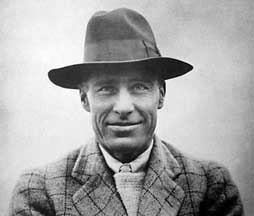Name Charles Rumsey Religion Episcopalian | Political party Democratic Party | |
 | ||
Resting place Forest Lawn Cemetery, Buffalo Children Charles Cary Harriman (b. 1911)Mary Averell (b. 1913)Bronson Harriman (1917–1939) Education Ecole nationale superieure des Beaux-Arts Similar People Mary Harriman Rumsey, E H Harriman, Mary Williamson Averell, W Averell Harriman, Samuel Wilkeson | ||
Cause of death Automobile accident | ||
Charles Cary Rumsey (August 29, 1879 – September 21, 1922) was an American sculptor and an eight-goal polo player.
Contents
Early life
Charles Rumsey was born on August 29, 1879 in Buffalo, New York. He was the son of Laurence Dana Rumsey, a successful local businessman, and Jennie Rumsey (née Cary). His maternal uncles included Seward Cary (1862-1948), a sculptor, and George Cary (1859-1945), a prominent architect. His maternal great-grandfather was Trumbull Cary (1787-1869), a New York State Senator and former New York State Bank Commissioner.
His siblings included: Evelyn Rumsey (1877-1963), who in 1922 married Rev. Walter R. Lord (1873-1952), Charles Cary Rumsey, Gertrude Rumsey (1880-?), who married Carlton Smith (?-1925), Grace Rumsey (1883-1963), who married 1908 Charles W. Goodyear Jr. (1883-1967), Laurence Dana Rumsey Jr. (1885-1967). As a child, Charles learned to play polo at a young age from his uncle and friend, Devereux Millburn.
Education
Charles Rumsey, who was known to his family & friends as Pad, graduated from Harvard University and studied art at the Boston Art School before going to Paris, France, in 1902 to study at the École des Beaux-Arts, where his uncle, George Cary, studied from 1886 until 1889.
Career
While still a student at Harvard, he exhibited a sculpture of an Indian at the Pan-American Exposition in Buffalo in 1901.
He worked mainly in bronze. His passion for horses saw him create statues of the Thoroughbred horses Hamburg and Burgomaster for Harry Payne Whitney, Good and Plenty for Thomas Hitchcock, and World Champion trotter Nancy Hanks for John E. Madden.
When Rumsey returned from Paris in 1906, he established himself in an art studio on 59th Street in New York City. He soon thereafter began sculptures for the massive house being built by architects Carrère and Hastings for the railroad magnate E.H. Harriman, called Arden; he did a fireplace surround and other sculptural decorations for the music room there, as well as the "Three Graces Fountain." During this time he courted Harriman's daughter, Mary Harriman; they both shared a love of horses and had first met at the Meadow Brook Steeplechase Association races on Long Island. They married in 1910, much to the surprise of New York society. They maintained a home in Brookville, New York on Long Island, where they raised three children.
Among Rumsey's other works, he did a statue of Francisco Pizarro erected in Trujillo, Spain, the Brownsville War Memorial in Brownsville, Brooklyn, a copy of the "Three Graces Fountain" from Arden House installed in Mirror Lake at Forest Lawn Cemetery, Buffalo (where Rumsey is buried), and the controversial figure of a nude woman called "The Pagan." Perhaps his most celebrated work is the 1916 frieze on Carrère and Hastings' Manhattan Bridge in New York City, titled "Buffalo Hunt."
Service in World War I
During World War I, Charles Rumsey served as a captain with Headquarters Troop, 77th Infantry Division and Fortieth Engineers, United States Army Corps of Engineers. His brother, Laurence Dana Rumsey, Jr. (1885–1967), was a pilot in the War with the famous Lafayette Escadrille and Lafayette Flying Corps.
Personal life
In 1910, Rumsey married Mary Harriman (1881–1934), the founder of The Junior League for the Promotion of Settlement Movements, later known as the Junior League of the City of New York of the Association of Junior Leagues International Inc. Mary was the daughter of railroad magnate E.H. Harriman and sister to W. Averell Harriman, former New York state governor and United States diplomat. In 2015 she was posthumously inducted into the National Women's Hall of Fame. Together they had three children:
On September 21, 1922, Charles Rumsey was a passenger in an automobile that crashed into a stone bridge abutment on the Jericho Turnpike near Floral Park on Long Island. He was thrown from the vehicle and died minutes later from his injuries. Rumsey was buried at Forest Lawn Cemetery in Buffalo, New York.
